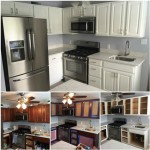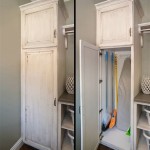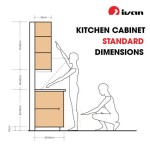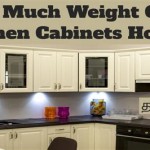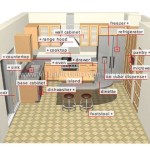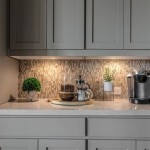Types of Kitchen Cabinet Styles
Kitchen cabinets are a fundamental element of any kitchen design, influencing both its functionality and aesthetics. The selection of cabinet style is a significant decision, as it defines the overall character of the space. A wide array of styles is available, each possessing unique characteristics that cater to diverse tastes and architectural designs. Understanding the nuances of these styles is crucial for creating a kitchen that is both visually appealing and functionally efficient.
This article will explore various kitchen cabinet styles, providing detailed descriptions and highlighting key features that distinguish them. By examining different designs, materials, and construction methods, readers can gain a comprehensive understanding of the options available and make informed decisions when planning their kitchen renovations or new builds.
Shaker Cabinets: Timeless Simplicity and Versatility
Shaker cabinets are characterized by their clean lines, minimalist design, and emphasis on functionality. This style is rooted in the principles of the Shaker religious community, who valued simplicity, utility, and craftsmanship. The typical Shaker cabinet features a five-piece door construction, consisting of a flat recessed center panel surrounded by a four-piece frame. This frame is usually composed of rails (horizontal pieces) and stiles (vertical pieces), joined together to create a clean, rectangular outline.
The appeal of Shaker cabinets lies in their versatility. They seamlessly integrate with various kitchen designs, ranging from traditional to contemporary. The simplicity of the design allows them to be easily customized with different hardware, finishes, and colors. Shaker cabinets can be painted in neutral tones for a classic, understated look, or they can be stained to highlight the natural grain of the wood. The adaptability of this style makes it a popular choice for homeowners seeking a timeless aesthetic.
Materials commonly used for Shaker cabinets include wood such as maple, cherry, oak, and poplar. Maple offers a smooth, even surface that is ideal for painting, while cherry and oak provide a warmer, more traditional look with their distinct grain patterns. The construction of Shaker cabinets typically involves solid wood frames and high-quality plywood or MDF (Medium-Density Fiberboard) for the center panel. This combination ensures durability and stability, ensuring that the cabinets can withstand the daily demands of a busy kitchen.
Furthermore, Shaker cabinets often feature simple, unadorned hardware, such as knobs or pulls with a clean, geometric design. This minimalist approach complements the overall aesthetic of the cabinets, maintaining the focus on the clean lines and simple form. The absence of elaborate detailing makes Shaker cabinets easy to clean and maintain, contributing to their practicality and longevity.
Contemporary Cabinets: Sleek, Modern, and Minimalist
Contemporary kitchen cabinets are defined by their sleek, minimalist design, emphasizing clean lines, smooth surfaces, and a focus on functionality. This style embraces modern materials and innovative construction techniques to create a streamlined and uncluttered aesthetic. Unlike traditional cabinet styles with intricate detailing, contemporary cabinets prioritize simplicity and a sense of openness.
A key characteristic of contemporary cabinets is the use of frameless construction, also known as European-style cabinets. Frameless cabinets eliminate the face frame that is traditionally found on cabinet fronts, resulting in a seamless and uninterrupted appearance. This construction method allows for greater accessibility to the cabinet interior and maximizes storage space. The doors and drawer fronts are typically full overlay, meaning they cover the entire cabinet box, creating a flush and unified look.
Materials commonly used for contemporary cabinets include laminate, wood veneer, metal, and glass. Laminate offers a durable, cost-effective option with a wide range of colors and textures. Wood veneer provides the natural beauty of wood with a more uniform appearance, while metal and glass accents add a touch of sophistication and modernity. High-gloss finishes are also popular in contemporary kitchens, reflecting light and creating a bright, airy atmosphere.
Hardware for contemporary cabinets is typically minimalist and streamlined, often featuring sleek pulls or integrated handles. Push-to-open mechanisms are also common, further enhancing the clean, uncluttered look. The use of concealed hinges and soft-close mechanisms adds to the overall functionality and sophistication of the cabinets.
Color palettes for contemporary cabinets tend to be neutral, with shades of white, gray, and black dominating. However, pops of color can be incorporated through accessories or accent elements to add visual interest and personality. The overall goal is to create a clean, modern, and functional kitchen space that reflects the homeowner's sophisticated taste.
Traditional Cabinets: Ornate Detailing and Timeless Elegance
Traditional kitchen cabinets are characterized by their ornate detailing, rich finishes, and emphasis on craftsmanship. This style draws inspiration from historical design periods, such as Victorian, Georgian, and Colonial, incorporating intricate moldings, raised panels, and decorative hardware to create a sense of timeless elegance and sophistication.
A hallmark of traditional cabinets is the use of framed construction, where a frame is attached to the front of the cabinet box. This frame provides structural support and adds a decorative element to the cabinet. The doors and drawer fronts typically feature raised panels, which create depth and dimension. Intricate moldings, such as crown molding, base molding, and decorative trim, are used to further enhance the ornate detailing of the cabinets.
Materials commonly used for traditional cabinets include wood such as cherry, maple, oak, and walnut. These woods are often stained or glazed to highlight the natural grain and add warmth and richness to the cabinets. Darker finishes, such as mahogany and espresso, are also popular in traditional kitchens. The use of solid wood construction is common, ensuring durability and longevity.
Hardware for traditional cabinets is typically ornate and decorative, featuring knobs and pulls with intricate designs and antique finishes. Brass, bronze, and antique silver are common hardware finishes that complement the overall aesthetic of the cabinets. Decorative hinges and other hardware elements are often used to further enhance the traditional look.
Color palettes for traditional cabinets tend to be warm and rich, with shades of cream, beige, and brown dominating. Accent colors, such as gold, burgundy, and deep green, can be used to add visual interest and create a sense of opulence. The overall goal is to create a warm, inviting, and elegant kitchen space that reflects the homeowner's appreciation for classic design.
Farmhouse Cabinets: Rustic Charm and Cottage Style
Farmhouse kitchen cabinets embody a rustic charm and cottage-style aesthetic, evoking a sense of warmth, comfort, and nostalgia. This style draws inspiration from rural farmhouses, incorporating natural materials, distressed finishes, and vintage-inspired details to create a relaxed and inviting atmosphere. Farmhouse cabinets are often characterized by their casual, unpretentious appearance, emphasizing functionality and a connection to nature.
Key features of farmhouse cabinets include shaker-style doors, beadboard panels, and open shelving. Shaker-style doors provide a simple, clean look that complements the rustic aesthetic, while beadboard panels add texture and visual interest. Open shelving is a common element in farmhouse kitchens, allowing homeowners to display dishes, cookware, and decorative items, adding a personal touch to the space.
Materials commonly used for farmhouse cabinets include wood such as pine, maple, and reclaimed wood. Pine offers a natural, rustic appearance, while maple provides a smooth surface for painting or staining. Reclaimed wood adds character and history to the cabinets, contributing to the overall farmhouse aesthetic. Distressed finishes, such as antiquing, distressing, and whitewashing, are often used to give the cabinets a weathered, vintage look.
Hardware for farmhouse cabinets is typically vintage-inspired, featuring knobs and pulls with rustic finishes, such as oil-rubbed bronze, antique brass, and wrought iron. Apron-front sinks are another common element in farmhouse kitchens, adding to the rustic charm and functionality of the space. Open shelving often features brackets with decorative details, further enhancing the farmhouse aesthetic.
Color palettes for farmhouse cabinets tend to be soft and muted, with shades of white, cream, gray, and light blue dominating. Pops of color can be incorporated through accessories or accent elements, such as colorful dishes, floral arrangements, and vintage signs. The overall goal is to create a warm, inviting, and comfortable kitchen space that reflects the homeowner's love of rustic charm and cottage style.
Transitional Cabinets: A Blend of Styles for Balanced Aesthetics
Transitional kitchen cabinets represent a harmonious blend of traditional and contemporary elements, creating a balanced and versatile aesthetic. This style seeks to bridge the gap between the ornate detailing of traditional cabinets and the sleek minimalism of contemporary designs, resulting in a timeless and sophisticated look. Transitional cabinets are often characterized by their clean lines, subtle detailing, and neutral color palettes.
A key characteristic of transitional cabinets is the use of shaker-style doors with subtle modifications, such as a slightly raised panel or a decorative edge. This provides a touch of traditional detail while maintaining a clean and contemporary appearance. The doors and drawer fronts are typically full overlay, creating a seamless and unified look, similar to contemporary cabinets.
Materials commonly used for transitional cabinets include wood such as maple, cherry, and oak. These woods are often painted in neutral colors, such as white, gray, or beige, to create a clean and sophisticated look. The use of mixed materials, such as wood and glass, is also common in transitional kitchens, adding visual interest and texture.
Hardware for transitional cabinets is typically simple and elegant, featuring knobs and pulls with clean lines and subtle detailing. Brushed nickel, stainless steel, and oil-rubbed bronze are common hardware finishes that complement the overall aesthetic of the cabinets. The use of under-cabinet lighting is also common in transitional kitchens, providing both functional and decorative lighting.
Color palettes for transitional cabinets tend to be neutral and sophisticated, with shades of white, gray, and beige dominating. Accent colors, such as blue, green, or black, can be used to add visual interest and personality. The overall goal is to create a timeless and elegant kitchen space that reflects the homeowner's refined taste and appreciation for both traditional and contemporary design.
Ultimately, the selection of a kitchen cabinet style should align with the overall design vision for the space and reflect the homeowner's personal preferences and lifestyle. Understanding the characteristics of each style is essential for creating a kitchen that is both visually appealing and functionally efficient.

Types Of Cabinet Doors 10 Popular Door Styles Cabinetdoors Com

Wonderful Photos Farmhouse Kitchen Cabinet Doors Style Door Styles Types Of Cabinets

8 Diffe Types Of Kitchen Cabinets You Ll Love

Basic Types Of Cabinet Doors Functional And Stylish In Your Kitchen Los Angeles

8 Diffe Types Of Kitchen Cabinets You Ll Love

A Comprehensive Guide To Various Kitchen Cabinet Styles

How To Choose Kitchen Cabinets When Remodeling

10 Types Of Kitchen Cabinets To Consider During A Remodel

10 Types Of Kitchen Cabinets To Consider During A Remodel

Kitchen Cabinet Door Styles Cabinets

